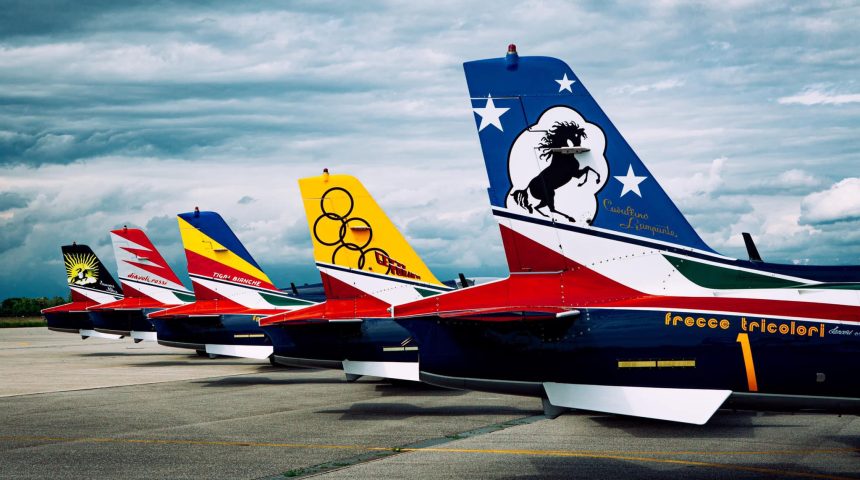MB-339A/PAN aircraft of the Frecce Tricolori were given special tail markings to celebrate the team’s 60th anniversary.
On May 23, 2021, the Aeronautica Militare (Italian Air Force) unveiled five MB-339 aircraft of the Frecce Tricolori display team, sporting brand new special tail markings. The five surprise “liveries”, inspired by the Italian Air Force display teams that represented Italy and its Air Force in the decade before the Frecce Tricolori were officially established, were unveiled with a video posted on the social channels of the Aeronautica Militare.
View this post on Instagram
The special tails of the five Frecce Tricolori’s aircraft have been adorned with symbols and markings inspired by the “Cavallino Rampante”, “Getti Tonanti”, “Tigri Bianche”, “Diavoli Rossi” and “Lancieri Neri”, the display teams that in the 1950s were given, on a rotational basis, the task of representing the Air Force at air shows and flyovers in Italy and abroad.
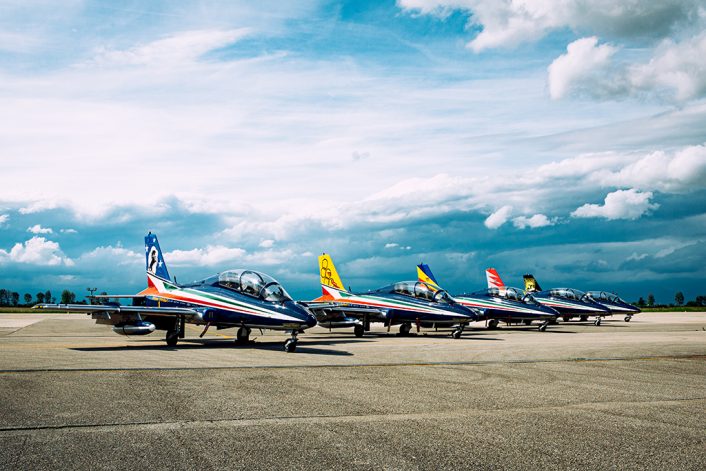
The liveries were created by the renowned Italian artist Mirco Pecorari of AircraftStudioDesign, who designed hundreds of liveries for aircraft all around the world (along with custom designs for cars, boats, collections etc). “I’ve re-imagined the emblems sported in the ’50s by the F-86s and F-84Fs belonging to the aerobatic display teams that preceded the Frecce Tricolori, so that they could be applied to the MB-339’s tail”, Mirco told us.
“The project calls for 11 aircraft to be given to the team’s jets: the idea is to have the 5 liveries applied to 5 pairs of MB-339s with an eleventh aircraft wearing a special tail with the 60th anniversary badge. […] Although it looks like they are painted, what you see on the tails of the aircraft are actually stickers: we have made several in-flight tests before we found out the right materials that could be installed on the aircraft, covering the existing paint, and would not be peeled off by the high-speed flying of the jets”.
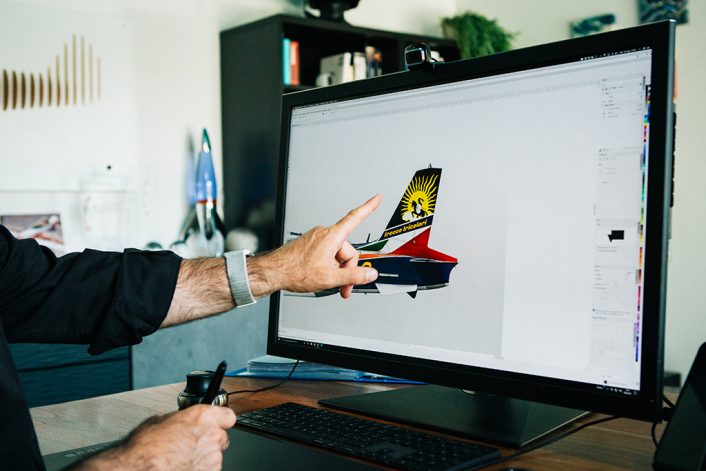
Before the Frecce were born.
The Capodichino-based 4° Stormo (Wing), which had recently been issued with the De Havilland DH 100 Vampire, was the first unit to be tasked with forming an aerobatic team in the aftermath of the war. This gave birth to the “Cavallino Rampante” (“Prancing Horse”) team, the denomination of which was inspired by the Wing’s heraldry. Equipped with only four aircraft, the team displayed in a 30-minute program, which included a simulation of an airfield attack and a minimum controllable airspeed pass with lowered landing gear along with some basic aerobatic manoeuvres such as loops and rolls. The team displayed for the first time in Rome on June 2, 1952, and performed its first transfer abroad to Melsbroek, Belgium, on Jul. 13 of the same year. Their success was such that the Air Force decided to follow up this type of activity.
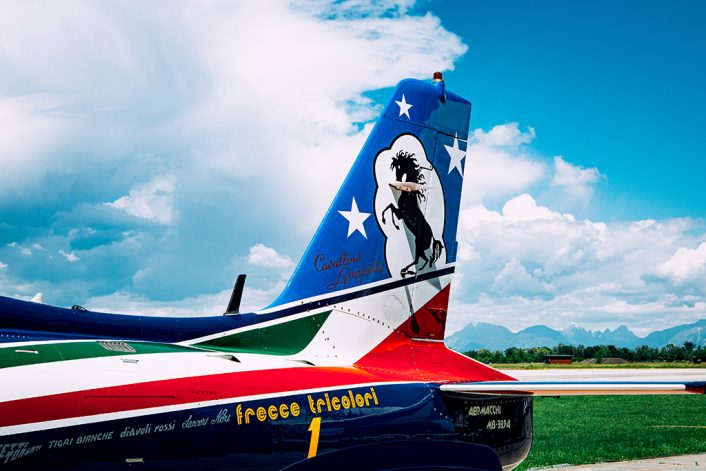
That same year, the Villafranca 5° Stormo (which became an Air Brigade in 1953) started to receive its first new Republic F-84G “Thunderjets”. With these aircraft the Unit and its three child Squadrons (the 101°, 102° and 103° Gruppo), was issued the task to form the new aerobatic team called “Guizzo” (after the 103° Gruppo radio callsign). The four “Guizzo” aircraft displayed for the first time on Apr. 14, 1953 at Villafranca airbase, followed by participation in airshows at Soesterberg (The Netherlands), Livorno, Lucca, Caselle and Centocelle and, in 1954, Madrid (Spain), Cologne and Nuremberg (Germany).
Starting from 1955, what had been until then an ad-hoc arrangement was made official: responsibility to represent the Air Force with an aerobatic team, would be assigned to each Fighter Unit on a rotating yearly basis. A team would serve as “reserve” for one year, and as “regular player” the following year.
In the meantime, in 1953, the Aviano-based 53^ Aerobrigata also gave birth to a new aerobatic team. Equipped with four F-84Gs, and initially known as “Bellagambi” Team, after its leader’s name, the team made its debut on Sept. 13, 1953, during an air show at Ferrara, where it was called on to represent the Air Force in lieu of the “Guizzo”, already engaged in Lucca. Decommissioned and re-constituted in 1955, the team was renamed “Tigri Bianche”(“White Tigers”, after the 21° Gruppo badge) and it was the first team to adopt a special livery to distinguish its aircraft from the ones in use with operational units.
Due to the involvement of the “Guizzos” in the making of the movie “I Quattro del Getto Tonante” (“The four of the thundering jet”, after the Italian translation of the F-84G nickname), a motion picture on the life of the team’s pilots, the “Tigri Bianche” performed a long series of successful exhibitions both in Italy and abroad during their first season as reserve team. Among the most important was the one performed at Tours (France), during which the four F-84 presented the downward bomb burst. Once the filming for the movie had been terminated, in 1956, the “Guizzos” changed their name to “Getti Tonanti” (Thundering Jets), taking part in some displays with a maneuver which was created especially for the shooting of the movie: the double roll.
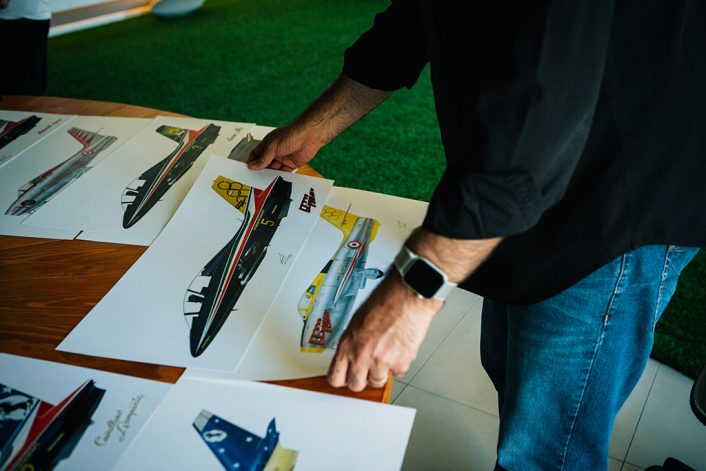
In 1957, the representative team was the “Cavallino Rampante” from the 4^ Aerobrigata, flying the Canadair CL13 Sabre MK4 (F-86E), equipped with smoke generating devices which could be controlled by the pilots and a coloured livery which decorated the entire aircraft. Their official debut was on Mar. 27 at Pratica di Mare airbase, while their display on Aug. 31, 1957, at Rimini airbase is remembered for the introduction into the team of a fifth aircraft, joining the original four.
The effective team in 1968 was the “Diavoli Rossi” (“Red Devils”), from the 6^ Aerobrigata, flying F-84F “Thunderstreak”, which had made its debut on 11 March 1957 at Vicenza airbase when serving as the reserve team. Beginning on Mar. 15, 1958, the team displayed with five aircraft plus one solo. With their seven F-84Fs, the “Diavoli Rossi” were present at many air shows. Particularly important was the one at Aviano during which the Italian team measured itself against the “Sky Blazers”; this presentation resulted in the achievements of the “Diavoli Rossi” provoking an invitation to display in the United States in April 1959, on the occasion of the first Las Vegas World Flight Congress. During their American tour, on which the “Diavoli Rossi” flew in F-84Fs made available by the Weapons School at Luke AFB, which were painted in a slightly different scheme than their usual, the team participated in several air displays among which, their last before returning home, was that over Coney Island, in New York bay, in front of a little less than a million spectators, including thousands of Italian nationals who had emigrated to the New Continent.
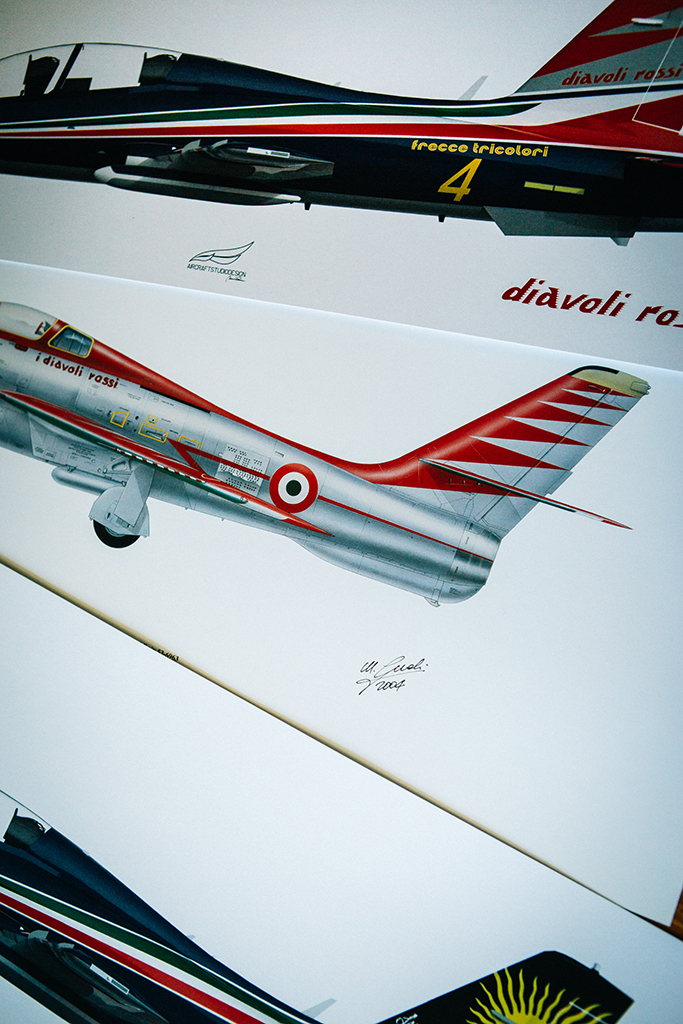
Meanwhile, at Cameri, the 2^ Aerobrigata’s “Lanceri Neri” (“Black Knights”) Team was created as the official formation for 1959, equipped with six black painted CL13s on which, for the first time ever, the national tricolour appeared under the wings and on the stabilisers. The team displayed at various national and international air events and featured in the longest formation transfer made by ItAF aircraft, taking part, following the invitation from Shah of Persia, in an important air show at Teheran.
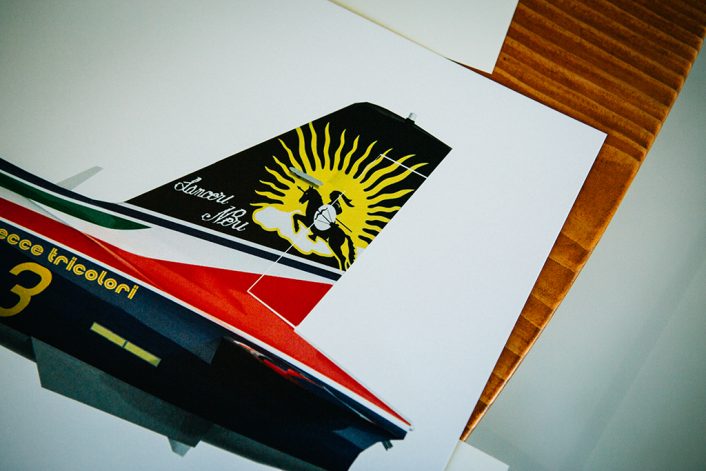
In 1959, the 5^ Aerobrigata’s “Getti Tonanti” returned with F-84Fs, initially flying standard colour aircraft on which only the “Goddess Diana the Hunter” logo featured, but which, beginning in the following season, and coinciding with the Rome Olympics, were decorated with the coloured rings symbol of the Olympic Games. Despite the fact that at the time the reserve role was assigned to the 4^ Aerobrigata, in 1960 the Air Force Staff decided to interrupt the team formation rotation principal in order to rationalise the employment of human resources and aircraft. The presence of two teams in two Air Brigades had become unsustainable, such was the effort in training the pilots, which diverted them from operational activity. It was thus decided to create an ad hoc unit which would be dedicated to aerobatics training.
On Jan. 16, 1961, through directive number 5567/243, the Air Staff issued a command for the constitution of the 313° Gruppo Addestramento Acrobatico, commencing on Jul. 1 of the same year, with home base in Rivolto airbase in the Udine province. In the new Squadron six CL13s were merged with four pilots from the 4^ Aerobrigata team, which in the original plan were due to have been appointed as the effective team that same year. These pilots were joined by others who had already served with the “Diavoli Rossi” and the “Tigri Bianche”. The “core” of these pilots came from the “Cavallino Rampante” team and were therefore entitled to choose the Unit’s radio call sign, which has survived until today: “Pony” – rather than “Freccia” (Italian for “Arrow”) or “Rivo” (after Rivolto), as some had suggested.
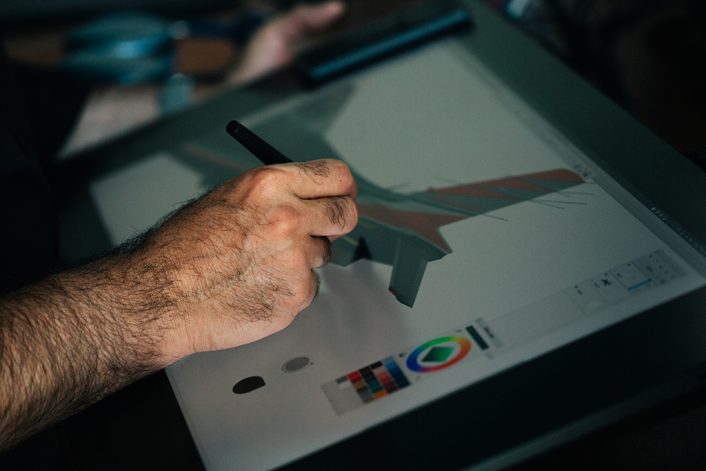
Previous special tails.
Back in 2015, to celebrate the 55th anniversary of the team (actually, the 55th display season) the MB-339 assigned to the Frecce Commander was the first aircraft to be painted with a special tail (with the tricolored stripes that cover the whole of it), special silhouettes of the aircraft flown by the team since 1961 (F-86, G.91 and MB.339) and was given the celebratory number #55 in yellow color (instead of the #0 carried usually sported by “Pony 0” the Commander’s plane).
The paint scheme was then applied to the rest of the aircraft and became the standard livery of the team. In the following years, only the individual number changed in position (from the central part of the tail to the rudder) and color (from yellow to black and white).

